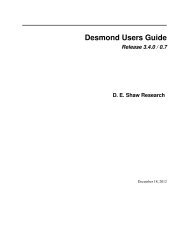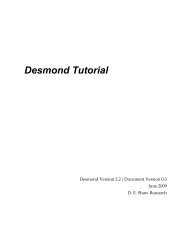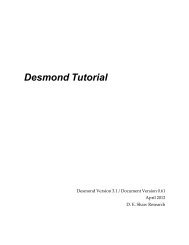Desmond Tutorial
Desmond Tutorial - DE Shaw Research
Desmond Tutorial - DE Shaw Research
- No tags were found...
You also want an ePaper? Increase the reach of your titles
YUMPU automatically turns print PDFs into web optimized ePapers that Google loves.
<strong>Desmond</strong> <strong>Tutorial</strong><br />
<strong>Tutorial</strong> Steps<br />
Figure 1.10 Protein Preparation Wizard — Interactive H-bond optimizer<br />
Click the ‘Analyze<br />
Network’ button.<br />
The OD2<br />
oxygen atom is<br />
protonated.<br />
The table is filled<br />
with the current<br />
protonation<br />
states of ASN,<br />
GLN, and HIS<br />
residues as well<br />
as initial OH bond<br />
orientations.<br />
Click the ‘Lock’ option for a<br />
residue to preserve its state.<br />
The Workspace is<br />
focused on the<br />
selected residue.<br />
Click the < and ><br />
buttons to flip<br />
through the<br />
protonation states<br />
and view changes<br />
immediately in the<br />
Workspace.<br />
NOTE<br />
NOTE<br />
Select an item in the table to focus the Workspace on the selected residue. For example,<br />
selecting item 8 in the table focuses the workspace on ASP50 as shown in<br />
Figure 1.10. Originally, this ASP residue was charged. By pressing the < and > buttons<br />
next to ASP50 in the table you can flip through all the different protonation states and<br />
immediately view the result in the Workspace. Figure 1.10 shows the Workspace<br />
when the OD2 oxygen atom is protonated (see the selected area). Similarly, residue<br />
states and OH orientations of other residues can be set manually and, if desired,<br />
locked by checking the Lock option.<br />
Finally, by clicking the Optimize All button you can re‐optimize the hydrogen bonding<br />
network. For further information about the Interactive H‐bond Optimizer click the<br />
Help button.<br />
14. Finally, provided that you have a Glide license from Schrödinger, the whole protein<br />
structure in the Workspace can be subjected to constrained refinement by clicking the<br />
Minimize button in the Impref minimization subpanel.<br />
The preferred renement procedure for MD simulations is to use <strong>Desmond</strong>ʹs own minimization/relaxation<br />
protocol (see below).<br />
The Protein Preparation Wizard cannot deal with the common case of missing side chains<br />
and missing residues that often plagues PDB structures. Before using the Protein Preparation<br />
Wizard, make sure that any missing parts of the protein structure are filled in. This<br />
tutorial describes a method using Schrödingerʹs Prime application. See “Preparing Proteins<br />
with Missing Residues or Side Chains” on page 29 for useful information on this<br />
subject. You will need a license from Schrödinger to use Prime. In lieu of Prime, you<br />
should use one of several tools available outside the Maestro environment.<br />
15. The 4pti structure is now ready for preparing a <strong>Desmond</strong> simulation. Select<br />
Applications > <strong>Desmond</strong> > System Builder as shown in Figure 1.11.<br />
September 2008 D. E. Shaw Research 11






